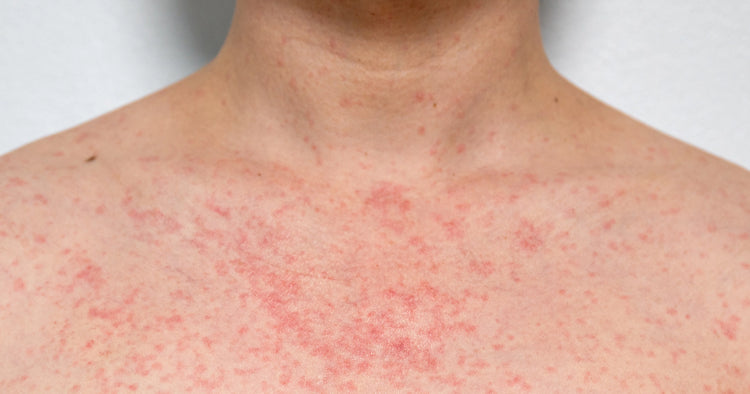Heat Rash: Causes, Symptoms, and Effective Treatments

What Is Heat Rash?
Heat rash, also known as miliaria or prickly heat, is a common skin condition that occurs when sweat ducts become blocked, trapping sweat beneath the skin. This leads to small, itchy red bumps, a prickling sensation, and sometimes mild inflammation. Heat rash is most common in hot, humid climates and can affect people of all ages, especially infants and those with sensitive skin.
Symptoms of Heat Rash
Heat rash symptoms can vary depending on the severity of the condition. The most common types include:
1. Miliaria Crystallina
- The mildest form of heat rash.
- Characterized by small, clear, fluid-filled blisters that break easily.
- Typically painless and resolves quickly.
2. Miliaria Rubra
- Known as prickly heat.
- Causes red bumps, itching, and a prickling sensation.
- Often occurs in areas where skin folds or clothing traps heat.
3. Miliaria Profunda
- A more severe form of heat rash.
- Sweat leaks into the deeper layers of the skin, causing firm, flesh-colored bumps.
- Can lead to heat exhaustion if untreated.
What Causes Heat Rash?
Heat rash occurs when sweat glands become blocked, preventing sweat from escaping. Common causes include:
- Hot and Humid Weather: High temperatures increase sweating, which can clog sweat ducts.
- Tight or Non-Breathable Clothing: Synthetic fabrics trap heat and moisture, exacerbating the condition.
- Excessive Physical Activity: Intense exercise or physical labor increases sweat production.
- Overuse of Skincare Products: Heavy creams or oils can block pores, leading to heat rash.
Heat Rash Treatment: How to Soothe Your Skin
Treating heat rash involves reducing sweating and cooling the skin. Here are some effective remedies:
- 1. Cool Compresses
- Apply a cold, damp cloth to the affected area to reduce itching and inflammation.
- 2. Wear Loose, Breathable Clothing
- Opt for lightweight, cotton fabrics to allow air circulation and prevent further irritation.
- 3. Use Calamine Lotion or Hydrocortisone Cream
- These over-the-counter treatments can soothe itching and reduce redness.
- 4. Take Cool Showers
- Rinse your skin with cool water to remove sweat and lower your body temperature.
- 5. Avoid Heavy Skincare Products
- Switch to lightweight, non-comedogenic moisturizers to prevent pore blockage.
- 6. Stay in Air-Conditioned Environments
- Keeping cool is essential to prevent heat rash from worsening.
Preventing Heat Rash: Tips for Healthy Skin
Preventing heat rash is often easier than treating it. Follow these tips to keep your skin healthy and rash-free:
- Stay Hydrated: Drink plenty of water to regulate your body temperature and prevent excessive sweating.
- Avoid Overheating: Use fans or air conditioning during hot weather to keep your body cool.
- Wear Breathable Fabrics: Choose lightweight, loose-fitting clothing made of natural fibers like cotton.
- Exfoliate Regularly: Gentle exfoliation can help prevent sweat ducts from clogging.
- Use Lightweight Skincare Products: Opt for gel-based or water-based moisturizers that won’t block pores.
- Use Sunscreen Regularly: Protect your skin from sun damage by applying a broad-spectrum, lightweight, and non-comedogenic sunscreen daily. Sunburn can exacerbate heat rash, so regular sunscreen use is crucial, even on cloudy days.
- Take Breaks During Physical Activity: If you’re exercising or working in a hot environment, take regular breaks to cool down.
Expert Opinions on Heat Rash
Dr. Emily Carter, a board-certified dermatologist, explains, "Heat rash is a common condition that can usually be managed with simple remedies like cooling the skin and avoiding excessive sweating. However, if the rash persists or becomes infected, it’s important to seek medical advice."
She also emphasizes the importance of prevention: "Wearing breathable clothing and staying hydrated are key to avoiding heat rash, especially in hot and humid climates."
When to See a Doctor for Heat Rash
While most cases of heat rash resolve on their own, there are situations where medical attention may be necessary. Consult a doctor if:
- The rash lasts longer than a week or worsens despite treatment.
- You notice signs of infection, such as pus, swelling, or fever.
- The rash is causing significant discomfort or interfering with daily activities.
Heat Rash in Infants: Special Considerations
Infants are particularly prone to heat rash due to their underdeveloped sweat glands. To prevent and treat heat rash in babies:
- Dress Them Lightly: Use soft, breathable fabrics to keep their skin cool.
- Keep Their Skin Dry: Gently pat their skin dry after sweating or bathing.
- Avoid Overheating: Ensure their sleeping area is well-ventilated and not too warm.
- Use Baby-Safe Products: Avoid heavy creams or oils that can block their delicate sweat glands.
If your baby’s heat rash doesn’t improve or shows signs of infection, consult a pediatrician.
Conclusion: Take Control of Your Skin Health
Heat rash is a manageable condition that can be treated with simple remedies and preventive measures. By staying cool, wearing breathable clothing, and using lightweight skincare products, you can reduce your risk of developing heat rash. If symptoms persist or worsen, don’t hesitate to seek medical advice.
Found this article helpful? Share it with friends, leave a comment below, or explore our other skincare products for more tips and insights!
FAQs About Heat Rash
1. Can heat rash go away on its own?
Yes, most cases of heat rash resolve within a few days with proper care and cooling.
2. Is heat rash contagious?
No, heat rash is not contagious and cannot spread from person to person.
3. Can I use aloe vera for heat rash?
Yes, aloe vera has cooling and anti-inflammatory properties that can help soothe heat rash.
4. When should I see a doctor for heat rash?
Seek medical attention if the rash persists for more than a week, worsens, or shows signs of infection.
5. How can I prevent heat rash during exercise?
Wear breathable clothing, stay hydrated, and take breaks to cool down during intense physical activity.
